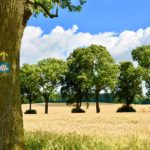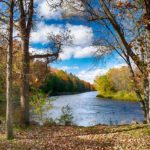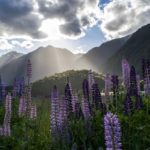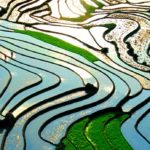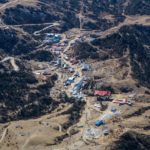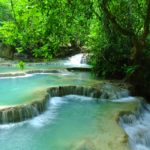Out of My Comfort Zone in the Nam Ha National Park Laos
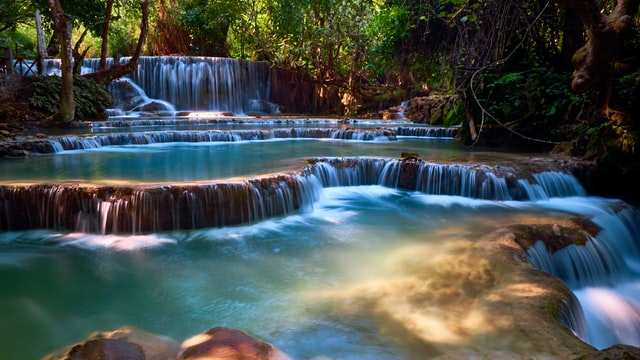
Resting on a faded, decorative cloth pad in an open-air lodge deep in the Nam Ha National Park Laos, at a Lanten village, my mind whirred, unable to settle. I wrapped my body tighter in my favorite purple scarf, attempting to fend off the bugs crawling across the floor and through my imagination. A smokey taste from dinner lingered in my mouth, and the saturated sounds of heavy breathing filled the air. It wouldn’t be until the following morning that I would realize the origin of the smokey taste – boiled river water.
When my partner and I, along with two friends we met while crossing the Thai border, signed up for this two-day trek and homestay in a village outside of Luang Namtha, we were promised two large bottles of water per day. With this in mind, we replenished over the course of the first day of hiking, only to discover the next day that the village was out of bottled water. This experience, along with many others during my time in Laos, reflected the vastness of my own privilege. It never ceased to amaze me how far out of my comfort zone I had walked.
It never ceased to amaze me how far out of my comfort zone I had walked.
I did not sleep that night, processing the past 48-hours in a country unlike any I had ever visited. We had set out that morning with bulging overnight packs and water. We were led by our Laotian guides and accompanied by a villager who brought us homemade lunch in his pack. After hiking up a steep incline for quite some time, we stopped at a small handmade table in the woods.
Our guide pointed out what looked like a bamboo dreamcatcher and explained that it was for protection from evil spirits in the forests. I recognized this as part of animism, a spiritual belief system followed and practiced by many Laos tribes, known there as ethnic minorities.
We ate our first of two meals on giant banana leaves rolled out onto the table. Greasy omelets, spicy eggplant, cashew chicken, and sticky rice soon filled the table. Although I had been trying to eat more bland food after getting food poisoning earlier, I realized this would not be possible for the remainder of the trip.
We discovered the next day that the village was out of bottled water. This experience, along with many others during my time in Laos, reflected the vastness of my own privilege. It never ceased to amaze me how far out of my comfort zone I had walked.
Along the way, our guide pointed out water-producing roots that he hacked down, herbal medicines used to stop bleeding, tart wild rhubarb, and bamboo stalks filled with water for us to drink. Since it was March, there was not much visibility of the surrounding mountain ranges. This time of year, known as the burning season, is extremely dry, accompanied by smokey skies and suffocating heat.
There are some forest fires but the majority of the smoke comes from farmers burning their crops in northern Laos, Thailand, and Myanmar. The mountain ranges trap the smoke and it covers the whole region with a thick smog until the rains come in late May. At this point, I was used to being constantly doused in my own sweat.
By the time we reached the village where we would be spending the night, I was ready to hop in the river. We stood in the water, watching men from the village use handmade slingshots to catch eel-like fish known as “bubble fish” for dinner. One of our friends tried his hand at the technique and successfully caught one. Water buffalo, pumpkin soup, and stewed tomatoes were also on the menu.
Chickens, pigs, puppies, and kittens roamed around freely, cared for by everyone.
After we finished eating, our guide walked us through the nearly 200-occupant village. I felt uncomfortable walking around, but also curious and reluctantly encouraged by our guide, who assured us this was part of the experience. Chickens, pigs, puppies, and kittens roamed around freely, cared for by everyone. People stoked fires as the sun went down and the stars slowly emerged.
We had hoped for more interaction with local villagers, but the language barrier posed a mighty challenge. Half of the Laos population belongs to an ethnic minority tribe. Each tribe has its own language and dialect, so the little Lao language we knew didn’t get us anywhere in the village. Only a few children giggled as they watched us from afar.
After a restless night, we packed up and were soon on our way. As we walked past a neighboring village along the path, we were swarmed by women and girls selling handmade jewelry in woven bamboo baskets. Each bracelet had a unique design, and quilted patches displayed images of daily life.
Emerging from the jungle, we entered open farmland.
The second day of hiking took us through a dense, old-growth jungle. Trees as large and wide as redwoods staggered above me. I could scarcely imagine how lush the canopy was during the rainy season. At one point, our guides stopped and without saying a word, began whittling us cups and chopsticks out of the tallest stalks of bamboo I have ever seen. We ate lunch from banana leaves again, sitting on the jungle floor. Both of our guides ate tiny, fiercely spicy red and green chilies with raw garlic fresh from a large bag.
Emerging from the jungle, we entered open farmland. A few kids ran past us on the path. Our journey ended when we got to the river. Two young boys who had sped passed us before pulled us across the water in a long, thin boat and we were on our way back to the Luang Namtha.
During the first half of the ride back we sat in silence, apart from the cacophonous racket inside the car from the unfinished roads covered in massive potholes. Once we got to a paved road everyone cheered and our guides gleefully turned on the radio, a familiar sound.
Photo for Out of My Comfort Zone in the Nam Tha National Park Laos by Unsplash.


